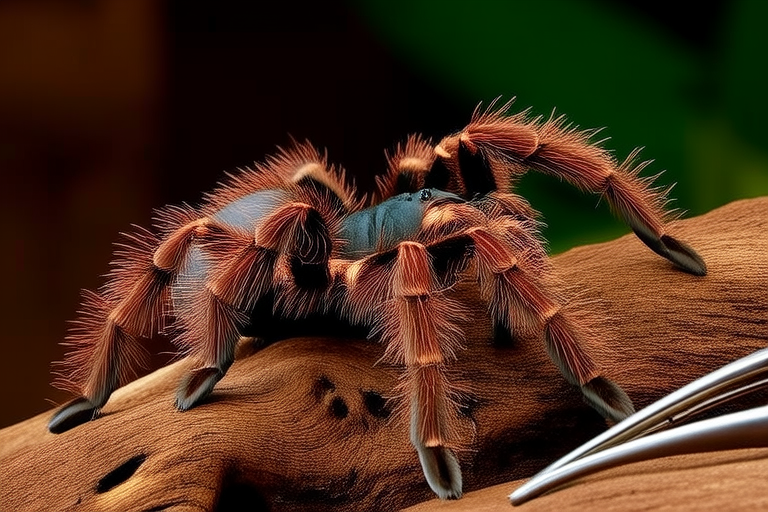
Meet Your New Co-Inhabitant: Caring for a Tarantula as a Unique Pet
Welcome to the fascinating world of tarantulas! These eight-legged creatures have long captured the imagination of pet enthusiasts and nature lovers alike. With their striking appearance and relatively low maintenance requirements, tarantulas make for intriguing and rewarding companions. However, owning a tarantula is not just about having a unique pet; it’s about understanding and respecting these arachnids’ specific needs and behaviors. This guide will walk you through everything you need to know to ensure your tarantula thrives in its new home.
Selecting the Right Species
The first step in caring for a tarantula is choosing the right species. There are over 900 known species of tarantulas, each with its own set of characteristics. Some are more docile and easier to handle, making them ideal for beginners, while others are more aggressive and require advanced care. Popular choices for novice owners include the Chilean Rose Hair, Mexican Red Knee, and Curly Hair tarantulas. These species are generally less skittish and more tolerant of handling. Always research the specific species you’re interested in to understand their particular needs and behaviors.
Setting Up the Habitat
A well-designed habitat is crucial for your tarantula’s health and happiness. A typical tarantula enclosure consists of a glass or plastic tank that provides adequate ventilation while preventing escapes. The size of the tank should be proportional to the tarantula’s size, typically allowing at least three times the leg span of the tarantula in height and width. The substrate can be coconut fiber, peat moss, or vermiculite, which retains moisture and mimics the tarantula’s natural environment. Add some hiding spots such as cork bark or half logs for your tarantula to feel secure. Additionally, provide a shallow water dish for drinking and humidity control.
Proper Diet and Feeding Schedules
Tarantulas are carnivorous and primarily feed on live insects. Crickets, mealworms, and dubia roaches are commonly used as food sources. The frequency of feeding depends on the tarantula’s age and size. Younger tarantulas may need to eat once or twice a week, while adults might only require feeding every two weeks. Overfeeding can lead to obesity and other health issues, so it’s important to monitor your tarantula’s eating habits. Always remove uneaten prey after a few hours to prevent stress or injury to your tarantula.
Handling Techniques
While tarantulas can be handled, it’s essential to approach this activity with caution and respect. Each tarantula has its own personality, and some may be more comfortable with handling than others. Before attempting to handle your tarantula, ensure it is calm and relaxed. Use a small, soft brush to gently coax it out of its hiding spot and onto a flat surface. Support the tarantula by holding it gently behind its abdomen, being careful not to squeeze or harm it. Keep handling sessions short and avoid disturbing your tarantula during molting periods, as they are particularly vulnerable at this time.
Common Health Issues
Like any pet, tarantulas can face health challenges. One of the most significant concerns is dehydration, which can occur if the humidity levels in the enclosure are too low. Signs of dehydration include a shriveled abdomen and lack of movement. To prevent this, regularly check the humidity levels and adjust the substrate as needed. Another common issue is molting problems, which can happen when the tarantula is unable to shed its exoskeleton properly. During molting, the tarantula will be extremely sensitive and should not be disturbed. If you notice any unusual behavior or physical changes, consult a veterinarian who specializes in exotic animals for guidance.
Understanding Behavior and Needs
One of the most rewarding aspects of owning a tarantula is observing its behavior and learning about its needs. Tarantulas are solitary creatures that prefer to live alone. They are nocturnal and spend much of their day hidden in their burrows or hiding spots. Understanding these habits can help you create an environment that meets their needs and promotes a healthy lifestyle. Additionally, tarantulas communicate through vibrations and chemical signals, which can sometimes be difficult for humans to interpret. Pay close attention to your tarantula’s movements and reactions to ensure you are providing the best possible care.
Where to Find Reliable Resources
Owning a tarantula is a long-term commitment that requires continuous learning and adaptation. To stay informed and ensure your tarantula receives the best care, seek out reliable resources. Join online forums and communities dedicated to tarantula enthusiasts, where you can exchange knowledge and experiences with fellow owners. Look for books and articles written by experienced keepers and veterinarians. Many local pet stores also offer workshops and seminars on tarantula care, providing valuable hands-on learning opportunities. By staying engaged with these resources, you’ll be better equipped to handle any challenges that come your way and continue to provide the best possible life for your tarantula.
In conclusion, tarantulas are captivating and unique pets that offer a rewarding experience for those willing to invest the time and effort into understanding and caring for them. By selecting the right species, setting up an appropriate habitat, providing a balanced diet, and understanding their behavior and needs, you can enjoy a fulfilling relationship with your new co-inhabitant. Remember, owning a tarantula is a serious commitment, but with the right knowledge and dedication, it can be one of the most enriching experiences in pet ownership.





